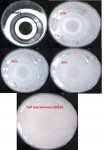Yesterday I received 8 oz of each the R00013 and the 50ppm test solution from TFTestKits. I have used just about half of the solutions in about 6 different attempts to calibrate my reading at 50ppm.
All of the samples keep reading at 30 or just a smidgen above 30 using the large tube that came with the kit. I tried adjusting the top of meniscus to bottom of the label and the bottom of meniscus to bottom of the label with No appreciable change in reading, all samples read somewhere very close to the 30 ppm line.
The 2 pics are the last sample (no different than previous samples) with the solution at the 50ppm line.
One pic has the camera light on, and one with out light.....the pic with the light on is closer to the actual image at waist level, outside, with back to 9:30 morning sun, cloudy day.
In both pictures the dot is clearly visible. What the heck am I doing wrong???
What the heck am I doing wrong?
All of the samples keep reading at 30 or just a smidgen above 30 using the large tube that came with the kit. I tried adjusting the top of meniscus to bottom of the label and the bottom of meniscus to bottom of the label with No appreciable change in reading, all samples read somewhere very close to the 30 ppm line.
The 2 pics are the last sample (no different than previous samples) with the solution at the 50ppm line.
One pic has the camera light on, and one with out light.....the pic with the light on is closer to the actual image at waist level, outside, with back to 9:30 morning sun, cloudy day.
In both pictures the dot is clearly visible. What the heck am I doing wrong???
What the heck am I doing wrong?
Last edited:



